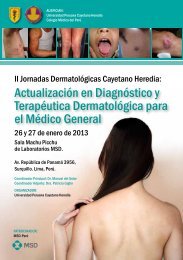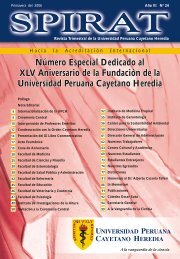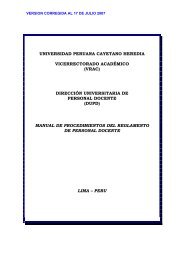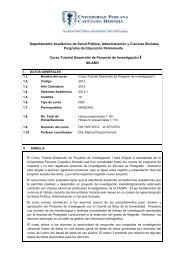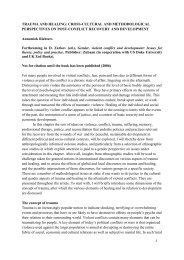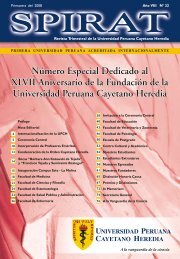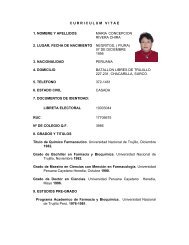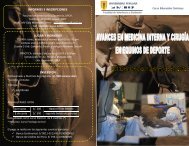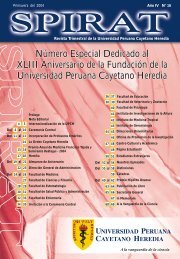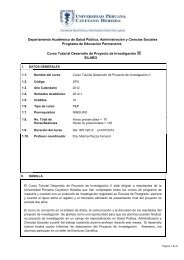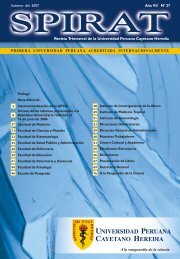Herbivore-induced, indirect plant defences - UPCH
Herbivore-induced, indirect plant defences - UPCH
Herbivore-induced, indirect plant defences - UPCH
You also want an ePaper? Increase the reach of your titles
YUMPU automatically turns print PDFs into web optimized ePapers that Google loves.
G. Arimura et al. / Biochimica et Biophysica Acta 1734 (2005) 91–111 101throughout the day. The secretion of nectar can followcircadian rhythms [177–180] or be relatively constantthroughout day and night [181,182].The mechanisms of nectar secretion are poorly understood:Some researchers have described secretion as apassive process, whereas others discuss it as an eliminationof surplus sugars [173]. However, there is evidence thatnectar secretion is an active secretory process: It requires theexpenditure of metabolic energy [183], and EF nectariesstrongly resemble secretory cells which contain largenumbers of mitochondria and show dense protoplasts andlarge nuclei [173]. Furthermore, the secretion of EFN can be<strong>induced</strong> by JA treatment. Originally discovered in Macarangatanarius [184], nectar secretion is suggested to beinducible by leaf damage. This seems to be a widespreadphenomenon [169,185–188], which may be linked to thesame or similar signalling pathways as those discussed forthe induction of volatile biosynthesis. Inhibitors thatsuppress the release of linolenic acid or interfere with theproduction of linolenic acid hydroperoxides completelysuppress the damage-<strong>induced</strong> flow of EFN and, hence,clearly demonstrate the involvement of oxylipin-basedsignalling in EFN-induction. Interestingly, also the attackof a below-ground herbivore (Agriotes lineatus) on cotton<strong>plant</strong>s (Gossypium herbaceum) <strong>induced</strong> above-groundproduction of EFN [185]. InVicia faba, even the numberof EF nectaries increased following leaf damage [189].Generally, the secretion of EFN is believed to function asan <strong>indirect</strong> anti-herbivore defence by attracting and henceincreasing the presence of putative <strong>plant</strong> defenders onnectar-secreting <strong>plant</strong> parts. Most studies focussed on theprotective effect of ants on entire <strong>plant</strong>s or individual <strong>plant</strong>parts, demonstrating a beneficial function of these insects[172,173]. However, contradictory observations thatdetected no measurable preventive effect of EFN-attractedants also exist [190–194]. In these cases, the lack ofprotection could be explained by, for example, (1) differencesin the aggressiveness of the attracted ant species[194–196], (2) differences in foraging behaviour of antspecies from different habitats [197,198], and (3) a varyingsusceptibility of the herbivores to ant predation [199,200].Besides ants, the EF nectaries attract a diverse spectrum ofother arthropods including Araneae, Diptera, Coleopteraand Hymenoptera (see [172] for review). Due to theirpredatory or parasitoid ways of life, many of these non-ants,such as ichneumonid, braconid and chalcidoid wasps [201–203], jumping spiders (Salticidae) [204], phytoseiid mites[205] or tachinid flies [206], can as well reduce the numberof herbivores. Both ants and wasps exerted beneficial effectson the EF nectary-bearing <strong>plant</strong> Turnera ulmifolia whenselectively excluded, yet no additive increase was observedwhen both insect groups had access [207].The emission of floral odours by <strong>plant</strong>s is very importantfor attracting pollinators to their floral nectars. Some ofthese floral nectars also scent by themselves [208], whereasnothing is known about the headspace of EFNs. Beyondthese odours, which communicate the location, abundance,and quality of these nectars to higher trophic levels, othermechanisms may help to guide EFN-feeding arthropods toremote nectar sources. First, some EF nectaries are colouredproviding visual cues for foraging arthropods [172]. Additionally,increased amounts of both HIPVs and EFN(Table 1) would allow foraging arthropods to use theemitted volatile organic compounds as a cue to detect nectarsources from longer distances. Future research should try todisentangle and quantify the costs and benefits of one ofthese <strong>indirect</strong> <strong>defences</strong> for a <strong>plant</strong> and figure out to whatextent each of them contributes to <strong>plant</strong> defence in nature.4.5. Evolution of HIPVs and EFNThe evolutionary origin of HIPV emission and EFNsecretion remains unknown. As described above, C 6 -volatiles or terpenoids may repel herbivores [123,209], betoxic for phytophages [210,211], or act anti-microbially[212]. HIPVs are therefore discussed as having originallyTable 1Compilation of species that are known to both emit HIPVs and feature extrafloral nectariesFamily Species Nectar inducible HIPVs inducible ReferencesEuphorbiaceae Manihot esculenta n.i. n.i. + H 1 [269,270]Leguminosae Phaseolus lunatus + JA + JA [169]Vicia faba n.i. n.i. + H 2 [271,272]Vignia unguiculata n.i. n.i. + H 3 [273,274]Malvaceae Gossypium herbaceum + M, H 4, 5 + H 5, 6 [185,186,275]Gossypium hirsutum n.i. n.i. + H 6, 7, 8 [202,276–278]Rosaceae Prunus serotina n.i. n.i. + H 9 [256,279]Salicaceae Populus deltoides n.i. n.i. + H 10 [91,280]Populus trichocarpa n.i. n.i. + H 10 [91,281]Solanaceae Solanum nigrum n.i. n.i. + H 11, 12 [282,283]Additional information on the inducibility of the respective trait is presented (for abbreviations see below).H 1, spider mite (Mononychellus tanajoa Bondar); H 2, pentatomid bug (Nezara viridula Linnaeus); H 3, spider mite (Tetranychus urticae Koch); H 4,Mediterranean brocade (Spodoptera littoralis Boisduval); H 5, wireworms (Agriotes lineatus Linnaeus); H 6, beet armyworm (Spodoptera exigua Hqbner); H7, tobacco budworm (Heliothis virescens Fabricius); H 8, corn earworm (Helicoverpa zea Boddie); H 9, forest cockchafe (Melolontha hippocastani Fabricius);H 10, forest tent caterpillar (Malacosoma disstria Hqbner); H 11, Colorado potato beetle (Leptinotarsa decemlineata Say); H 12, death’s head hawkmoth(Acherontia atropos Linnaeus); JA, jasmonic acid; M, mechanical damage; n.i., not investigated.



